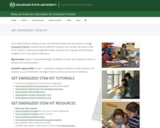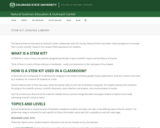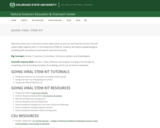
This softchalk lesson is for a 4th grade steam class or 4th grade science.
- Subject:
- Life Science
- Material Type:
- Unit of Study
- Provider:
- AEA PD Online
- Date Added:
- 04/07/2023

This softchalk lesson is for a 4th grade steam class or 4th grade science.

From the earliest days of settlement and migration, the people of North America have relied on maps and mapping to understand their environment and place within it. Maps have helped Americans prospect investments, comprehend war, and plan leisure in places unknown. As Americans have used maps to explore the U.S., capitalize on its resources, and displace its Native peoples, maps have shaped American cultural ideas about travel, place, and ownership. This exhibit explores the cultural and historic impact of mapping through four specific moments in American history: migration along the Oregon Trail, the rise of the lumber industry, the Civil War, and the popularization of the automobile and individual tourism. It concludes with a look at maps in the age of computers, the Internet, and beyond. These moments demonstrate the influence maps have had over how Americans imagine, exploit, and interact with national geographies and local places. This exhibition was created as part of the DPLAs Digital Curation Program by the following students in Professor Helene Williams's capstone course at the Information School at the University of Washington: Greg Bem, Kili Bergau, Emily Felt, and Jessica Blanchard. Additional revisions and selections made by Greg Bem.

Students gather factual information about frogs and toads to create nonfiction and fiction stories. Drawing is used for prewriting.

Students bring the print-rich environment of the community into the classroom through the use of environmental print, enabling emergent readers to delight in the realization that they are indeed readers.

In this MS/HS unit supported by NASA, students engage with online interactives, authentic datasets, and citizen science protocols to construct models and explanations for the unit driving question, "How do landscapes recover after a wildfire?"

Fósiles Realmente Antiguos Equipo STEM. El Centro de Extensión y Educación en Ciencias Naturales colabora con la facultad de CSU, los Parques Nacionales y los programas de ciencia ciudadana para traducir su investigación científica actual en experiencias STEM únicas para los estudiantes en forma de kits educativos que se pueden prestar. Cada kit contiene casi todos los materiales necesarios (menos cosas comunes como agua y toallas de papel) para explorar algunos temas de investigación científica realmente interesantes. enviando un formulario de recogida local disponible en el sitio web vinculado. Utilice la información de contacto en la página de descripción general del kit STEM para obtener más información. https://www.cns-eoc.colostate.edu/stem-kits/ Debido al peso extremo de la arena utilizada en este kit, la única opción es la recogida local. Este kit se proporciona de forma gratuita para uso educativo.

This science resource covers a variety of topics; however, the specific URL is on Genetics. It has significant explanations on the basic Principles of Genetics, Co-dominance, Incomplete dominance, and Sex-Linked traits. The units have precise and manageable explanations, and there are numerous links and additional resources to support instructors and students to advance learning. The access to videos and online simulations enhances particular areas, and the diverse assessments support mastery of skills.
This is a very purposeful resource on genetics; it is useful to make learning more effective either as an overall instructional method or as an individualized learning supplement.

Three years before the United States entered World War II, President Roosevelt declared the South to be "the nation's number one economic problem." Georgia's economy was distinctly agricultural and low-wage, with little manufacturing compared with states in the North and Midwest. The median family income was nearly half of the national average. One year later, an influx of federal defense money established new industries, such as the Bell Aircraft plant in Marietta, and expanded existing ones, such as the J. A. Jones Construction Company in Brunswick. While 320,000 Georgians served in the United States Armed Forces, tens of thousands of Georgians repaired aircraft, built B-29 bombers, and worked in shipyards at home during the war. Meanwhile, military training was widespread throughout Georgia, occupying its fields as well as skies. Capitalizing on the state's flat coastal region and mild winters, Army airfields were installed in Savannah, Statesboro, Thomasville, and Waycross, and pilots trained in Albany, Augusta, Americus, and Douglas. Thousands of soldiers passed through Fort Benning and Fort Oglethorpe, where members of the Women's Army Corps trained for positions at home and abroad. World War II employment was crucial to the economic development of the state, ushering in the transformation to a modern, industrial, and diverse Georgia. This exhibition was created as part of the DPLA's Public Library Partnerships Project by collaborators from the Digital Library of Georgia and Georgia's public libraries. Exhibition organizers: Mandy Mastrovita and Greer Martin.

Get Energized! STEM Kit. The Natural Sciences Education & Outreach Center collaborates with CSU faculty, National Parks and citizen science programs to translate their current scientific research into unique STEM experiences for students in the form of Educational Kits that can be checked out. Each kit contains just about all of the materials needed (minus common things like water and paper towels) to explore some really interesting scientific research topics.The kits are available for teachers and informal educators in Colorado to check out for a duration of a week by submitting either a local pickup form or a delivery form available at the linked website. This kit is provided free for educational use. This Kit is available in Spanish.

GetWET Water Education (Special Training Required for teachers prior to use, read about the requirements on the linked page). The Natural Sciences Education & Outreach Center collaborates with CSU faculty, National Parks and citizen science programs to translate their current scientific research into unique STEM experiences for students in the form of Educational Kits that can be checked out. Each kit contains just about all of the materials needed (minus common things like water and paper towels) to explore some really interesting scientific research topics.The kits are available for teachers and informal educators in Colorado to check out for a duration of a week by submitting either a local pickup form or a delivery form available at the linked website. This kit is provided free for educational use. This Kit is available in Spanish.

Students present monologues in the "voice" of someone involved in child labor in England, respond to questions, and then discuss contemporary child laborers and compare them to the past.

Students write and record their own essays for a class blog by first completing a series of activities designed to get them thinking and writing about their experiences.

This kit provides the materials and background information needed to engage students in a dynamic and constructive process of learning how global media perspectives differ based on country of production, media source, target audience, and political and social context. There are five lessons representing important issues and media documents from: Africa (news and documentary film clips about the food crisis), Latin America (editorial cartoons about immigration), Europe (news and documentary film clips about Islam and cultural identity), India (magazine covers about India's rise in the global economy), and Southeast Asia (websites concerning Islamic majorities and minorities).

This lesson provides teachers with support for using text-dependent questions and Common Core literacy strategies to help students derive big ideas and key understandings while developing vocabulary using the biographic text, Gloria Estefan. Along with her worldwide musical fame, Gloria Estefan also experienced tragedy, but continued to help others in unfortunate situations. Gloriaĺĺs success has allowed her to receive multiple honors and awards for her selfless work leading to her being referred to as "a star with a heart."

Going Viral STEM Kit. The Natural Sciences Education & Outreach Center collaborates with CSU faculty, National Parks and citizen science programs to translate their current scientific research into unique STEM experiences for students in the form of Educational Kits that can be checked out. Each kit contains just about all of the materials needed (minus common things like water and paper towels) to explore some really interesting scientific research topics.The kits are available for teachers and informal educators in Colorado to check out for a duration of a week by submitting either a local pickup form or a delivery form available at the linked website. Please use the contact information on the STEM Kit overview page to learn more. https://www.cns-eoc.colostate.edu/stem-kits/ This kit is provided free for educational use. This resource is also available in Spanish in the linked file.

Tuning into the radio is now an integrated part of our everyday lives. We tune in while we drive, while we work, while we cook in our kitchens. Just 100 years ago, it was a novelty to turn on a radio. The radio emerged at the turn of the twentieth century, the result of decades of scientific experimentation with the theory that information could be transmitted over long distances. Radio as a medium reached its peakthe so-called Radio Golden Ageduring the Great Depression and World War II. This was a time when the world was rapidly changing, and for the first time Americans experienced those history-making events as they happened. The emergence and popularity of radio shifted not just the way Americans across the country experienced news and entertainment, but also the way they communicated. This exhibition explores the development, rise, and adaptation of the radio, and its impact on American culture.

Additional Language and Literacy (ALL) Block component of Grade 3: Module 1: Unit 1 of the EL Education K-8 Language Arts Curriculum. The ALL Block is one hour of differentiated small group instruction aligned to the module content, giving students further practice with key literacy skills. This unit's ALL Block curriculum complements the Grade 3 module Overcoming Learning Challenges Near and Far. For more information on the ALL Block, please visit https://curriculum.eleducation.org/about-k-2-labs-and-ALL-block.

Additional Language and Literacy (ALL) Block component of Grade 3: Module 1: Unit 2 of the EL Education K-8 Language Arts Curriculum. The ALL Block is one hour of differentiated small group instruction aligned to the module content, giving students further practice with key literacy skills. This unit's ALL Block curriculum complements the Grade 3 module Overcoming Learning Challenges Near and Far. For more information on the ALL Block, please visit https://curriculum.eleducation.org/about-k-2-labs-and-ALL-block.

Additional Language and Literacy (ALL) Block component of Grade 3: Module 1: Unit 3 of the EL Education K-8 Language Arts Curriculum. The ALL Block is one hour of differentiated small group instruction aligned to the module content, giving students further practice with key literacy skills. This unit's ALL Block curriculum complements the Grade 3 module Overcoming Learning Challenges Near and Far. For more information on the ALL Block, please visit https://curriculum.eleducation.org/about-k-2-labs-and-ALL-block.

Additional Language and Literacy (ALL) Block component of Grade 3: Module 2: Unit 1 of the EL Education K-8 Language Arts Curriculum. The ALL Block is one hour of differentiated small group instruction aligned to the module content, giving students further practice with key literacy skills. This unit's ALL Block curriculum complements the Grade 3 module Adaptations and the Wide World of Frogs. For more information on the ALL Block, please visit https://curriculum.eleducation.org/about-k-2-labs-and-ALL-block.